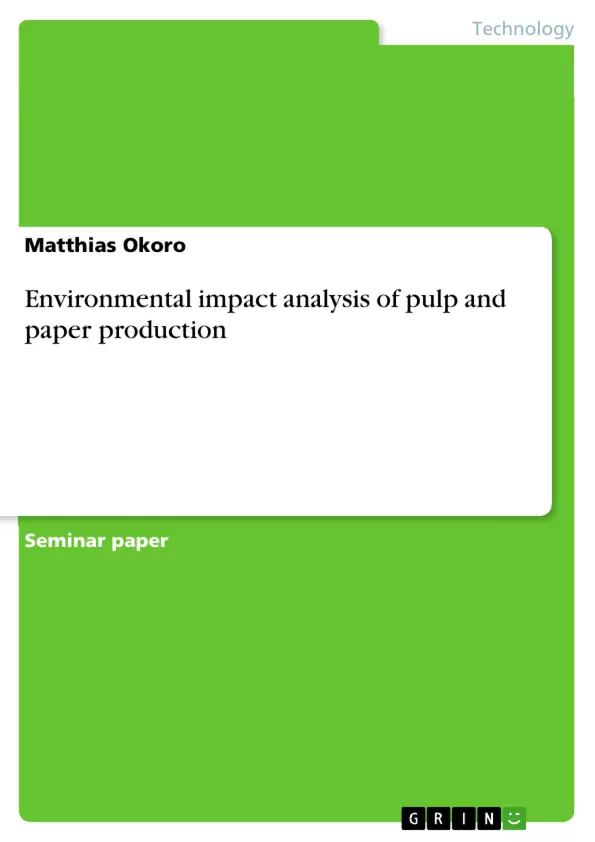The complexity of the paper issue means that firm conclusions are hard to draw. All paper manufactures causes harm to the environment and more often than not the determining factors in a paper mills. Environmental performance is not the process, paper type or fiber source but the location, mill practice and mill operator. Hence to try to grade paper products or production techniques into some kind of hierarchy of environmental performance, based solely on the manufacture process, is extremely difficult. Yet, globally however, the environmental impact of paper is significant, which has led to changes in industry and behavior at both business and personal levels. With the use of modern technology such as the printing press and the highly mechanized harvesting of wood, paper has become a cheap commodity everywhere. This has led to a high level of consumption and waste. With the rise in environmental awareness on the pollution of the Eco- system by the effluent of pulp and paper it became imperative to run a clearer analysis of its environmental impact.
Table of Contents
- 1.1 INTRODUCTION
- 1.2 Statement of the Problem
- 1.3 Aim
- 1.4 Objectives
- 2.1 LITERATUR/ READING
- 3.1 PULP AND PAPER MANUFACTURING PROCESSES
- 3.2 Pulp
- 3.2.1 Chemical pulping
- 3.2.2 Mechanical pulping
- 3.3 Bleaching
- 3.4 Paper Production
- 4.1 ENVIRONMENTAL IMPACT ANALYSIS
- 4.2 General Organic Pollution and Suspended Solids
- 4.3 Acidic Compounds
- 4.4 Environmental Impact of Chlorine Compounds
- 4.5.1 Chlorophenolics
- 4.5.2 Dioxins (PCDD) and Furans (P CDF)
- 4.5.3 Chloroform and Other Neutral Chlorinated Compounds
- 4.6 Other Environmental Issues Relating to Effluent Discharge
- 4.7 Impact on Forest
- 4.8 Impact on Biodiversity
- 4.9 Impact on the Atmosphere
- 4.10 Impact on Poly Culture
- 4.11 Impact on water
- 5.1 ALTERNATIVE PROCESSES OF PULP AND PAPER PRODUCTION
- 5.2 Recycled Fiber
- 5.3 Production
- 5.3.1 Mechanical pulping
- 5.4 Environmental impacts of the recycling process
- 5.4.1 Wastewater Emissions
- 5.4.2 Air Emissions
- 5.4.3 Solid Waste
- 5.4.4 Energy use
- 5.4.5 Water Use
- 5.4.6 Life Cycle Analyses
- 5.5 Non-Wood Fiber Sources
- 5.6 Non-Wood Fiber Types
- 5.7 Environmental Impacts of Non-Wood Fiber Pulp and Paper
- 5.7.1 Crop Production
- 5.8 The Manufacture Process
- 6.1 SUMMERY
- 6.2 Recommendation
Objectives and Key Themes
This work aims to provide a comprehensive analysis of the environmental impact of pulp and paper production. The study explores various aspects of paper manufacturing, including pulp production, bleaching, and papermaking processes, to evaluate their effects on the environment. Key themes explored in the text include:- The environmental impact of traditional pulp and paper production
- The impact of various chemical compounds used in the manufacturing process
- The effects of paper production on forests, biodiversity, and water resources
- Alternative paper production methods, including recycled fiber and non-wood fiber sources
- The environmental benefits and drawbacks of different paper production techniques
Chapter Summaries
- Chapter 1: Introduction introduces the topic of the environmental impact of pulp and paper production. The chapter defines the problem and outlines the aim and objectives of the research.
- Chapter 2: Literatur/ Reading (not included in the preview).
- Chapter 3: Pulp and Paper Manufacturing Processes provides a detailed overview of the various stages involved in pulp and paper production. It explains the differences between chemical and mechanical pulping processes, as well as the bleaching process.
- Chapter 4: Environmental Impact Analysis analyzes the environmental impact of pulp and paper production. It focuses on the pollution caused by various chemicals used in the manufacturing process, including acidic compounds, chlorine compounds, and organochlorine products. It also examines the impact of paper production on forests, biodiversity, and water resources.
- Chapter 5: Alternative Processes of Pulp and Paper Production explores alternative approaches to paper production, including recycled fiber and non-wood fiber sources. It examines the environmental impacts of these alternative methods and compares them to traditional paper production.
Keywords
The main keywords and topics of this research are: pulp and paper production, environmental impact, pollution, effluent discharge, chemical pulping, mechanical pulping, bleaching, recycled fiber, non-wood fiber, forest impact, biodiversity impact, water pollution, and sustainable paper production.- Quote paper
- Matthias Okoro (Author), 2012, Environmental impact analysis of pulp and paper production, Munich, GRIN Verlag, https://www.grin.com/document/281546



